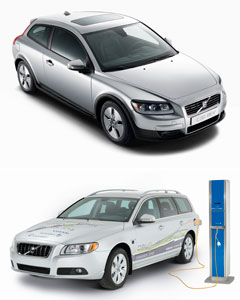Make / Model Search
News - VolvoVolvo puts zap into battery safetyCop that: Volvo puts a plug-in hybrid V70 wagon through a rear-end sled crash test in its research into electric vehicle safety. Electric vehicles must be as safe as other cars, says Volvo12 Nov 2009 VOLVO – the safety-first company that is planning to introduce the world’s first urban pedestrian collision avoidance system in its new S60 sedan next year – also hopes to steal the march on its rivals in another emerging field of safety: electric vehicles. The Swedish manufacturer is working on what it describes as “a comprehensive safety package of the very highest class” for a new generation of electric vehicles that can pose unique threats compared with traditional fossil-fuel vehicles. And while Volvo has been willing to share its ideas with rivals on other safety issues, such as car-to-car crash avoidance communication technology, and – way back – three-point seatbelts, it plans to hide its EV safety advances under a bushel until it is ready to roll out its own battery-powered cars, starting with a plug-in hybrid in 2012. Volvo Car Corporation government affairs director Anders Eugensson, in Australia to address the 2009 Australasia Road Safety Research, Policing and Education Conference in Sydney, summed up Volvo’s competitive stance: “We like to make a safer product.”  Left: Volvo C30 BEV electric concept. Below: Volvo V70 plug-in hybrid concept. Left: Volvo C30 BEV electric concept. Below: Volvo V70 plug-in hybrid concept.Mr Eugensson said that ultimately, uniform standards would have to be set by governments on some aspects of EV safety, but for now at Volvo “we like to make our own standards”. Volvo unveiled its first full-electric vehicle concept, the C30-based BEV (Battery Electric Vehicle), at the Frankfurt motor show in September. Armed with an 84kW electric motor and lithium-ion batteries that hold 24kWh of power, the BEV has a range of between 120km and 150km, depending on driving conditions, and a top speed of 130km/h. Volvo says the BEV can sprint from zero to 100km/h on 10.5 seconds, but its best acceleration is up to 60km/h – ideal for urban work. Re-charging takes about eight hours on a conventional 240-volt household socket. The company says it has built a small number of C30 BEVs for testing, with the electric motor under the bonnet and the battery installed down the centre of the car. A plug-in hybrid with a range of 1200km (50km on pure electricity) is also said to be under development by Volvo for release in 2012. Volvo says its policy is to impose the same high safety standards on all vehicles, regardless of car type or power source. While the same research and testing protocols would be applied to EVs as other cars, Volvo says work on electrification is being approached “with a great deal of humility and open-mindedness” because of the infancy of the technology. While test cars will venture forth from the Volvo proving ground for field testing next year, Volvo says most of its focus at this stage is at the component level to see how the battery is affected by harsh braking and collision. As well, Volvo is working on battery monitoring and temperature control systems, to ensure that even under normal motoring, batteries do not overheat with potentially nasty consequences. Another focus is on the effects of battery weight on vehicle dynamics in, for example, fast avoidance manoeuvres. Volvo says the battery in its plug-in hybrid weighs 150kg – a load that changes vehicle behaviour. In a crash, the battery must be well protected to avoid damage, especially in rear-end collisions. For this, Volvo is working on methods of encapsulating the battery to shield it from damage, as well as positioning it well away from crumple zones. In case the battery is pierced, special ducts are needed to evacuate leaking gas, while crash sensors are also required to shut down the electrics to prevent electrocution of occupants or rescuers. Testing even extends vehicle servicing and recycling safety. While plug-in hybrid and full-electric vehicles are both in development stages at Volvo, it has abandoned plans for conventional hybrid cars, in which it had intended to use its new diesel engines coupled with an electric drive system. Instead, it has jumped straight to plug-ins as the logical next step.  Read more |
Click to shareVolvo articlesResearch Volvo Motor industry news |












Facebook Twitter Instagram